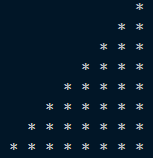Problem Statement:
Write a program to draw the following pattern:
*
* *
* * *
* * * *
* * * * *
(Take a variable n which decides the number of rows, for above example, n=5)
THE CODE
Output:
Simplification:
In the above problem, the value of n is 8 (i.e.,
the number of rows is 8)
1. The first for loop is
used to define the rows.
It is having a counter variable i with an initial
value of 1 followed by a conditional statement, i less than or equal to
n. It is having an updating statement i++. Inside the
loop's body we further have two for loops and a print statement System.out.println(
) for jumping on to the next line (to change the row) after each
column in the particular row has been printed.
2. The second for loop is
used to print white space.
It
is having a counter variable j with an initial value of 1 followed by a
conditional statement, j less than or equal to n-i. It is having an
updating statement j++. Inside the loop's body a print
statement System.out.print(" ") for printing white
space characters column-wise, i.e., columns where *(star) is not required.
3. The third for loop is
used to print stars (*).
This
loop will start after the second for loop terminates. It
is having a counter variable k with an initial value of 1 followed by a
conditional statement, k less than or equal to i. It is having an
updating statement k++. Inside the loop's a print statement System.out.print("*
") for printing *(star) column-wise.
When
the third loop terminates the execution will jump on the print statement of the
first for loop, that is, System.out.println( ) which
changes the row in the output. After this, execution will check the conditional
statement in the first for loop, if the
condition is true the process will continue and if the
condition is false the entire loop terminates.
Hope
you liked this explanation, for any feedback or doubt you can comment down in the comment
section


